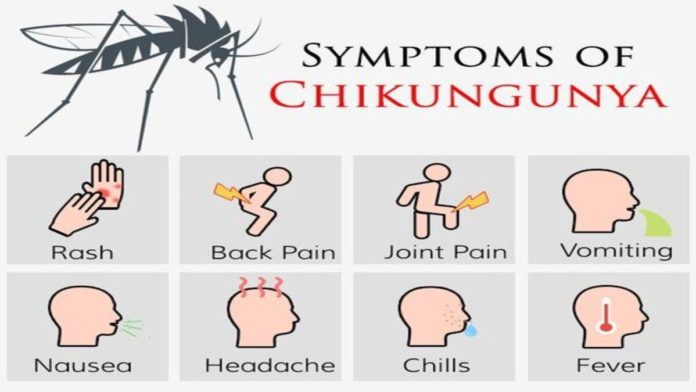Chikungunya is a viral disease transmitted to humans by infected mosquitoes. It is caused by the chikungunya virus and is characterized by sudden fever and joint pain that can be severe and debilitating.
Causes and Risk Factors of Chikungunya
Chikungunya is a viral disease transmitted to humans by infected mosquitoes. It is caused by the chikungunya virus (CHIKV).
An infected person cannot directly transmit the virus to another person. The disease is spread when a mosquito feeds on a person with the virus circulating in their blood. The mosquito can pick up the virus and spread it to another person through its bite.
Chikungunya virus is most often spread to people by Aedes aegypti and Aedes albopictus mosquitoes. These are the same mosquitoes that transmit dengue virus.
Proximity of mosquito breeding sites to human habitation is a significant risk factor for chikungunya.
Duration of Chikungunya
Complications of Chikungunya
Serious complications are not common, but occasionally infection can lead to serious problems of the skin, eyes, kidneys, heart, or nervous system.
Rare but serious complications include:
- Myocarditis
- Ocular disease (uveitis, retinitis)
- Hepatitis
- Acute renal disease
- Severe bullous lesions
- Neurologic disease such as meningoencephalitis, Guillain-Barré syndrome, myelitis, or cranial nerve palsies
Related Conditions of Chikungunya
The symptoms of chikungunya are similar to those of dengue and Zika, diseases spread by the same mosquitoes that transmit chikungunya. Chikungunya can be misdiagnosed in areas where the three diseases are common. Dengue fever is more lethal than chikungunya, and prompt recognition and treatment of it can be lifesaving.
Resources We Love
ClinicalTrials.gov
A great resource from U.S. National Library of Medicine where you can search a database of more than 360,000 research studies in all 50 states and 219 countries. If you are interested in participating in a clinical trial, you can find information here about studies that are currently or soon to be recruiting including eligibility criteria, details on how they are being conducted and length of participation. The database also includes details of completed studies that may provide you with information about treatments and therapies soon to be in the pipeline.
Genetic and Rare Diseases Information Center (GARD)
A program of the National Center for Advancing Translational Sciences (NCATS), GARD offers reliable information on more than 6,500 conditions, including chikungunya. In addition to up-to-date information on the diseases, you can search a database of orphan drugs (treatments the U.S. Food and Drug Administration has approved for rare diseases) to learn more about available treatments. If you can't find the information you are looking for on the site, you can contact one of their information specialists by phone or email for answers to your questions.
National Organization for Rare Disorders (NORD)
This patient advocacy organization has a mission to improve the lives of individuals and families affected by rare diseases, including chikungunya. On NORD's website, you will find detailed information about your disease or disorder as well as guidelines to help you locate an experienced specialist.
Additional reporting by Ingrid Strauch.
Editorial Sources and Fact-Checking
- Silva LA, Dermody TS. Chikungunya Virus: Epidemiology, Replication, Disease Mechanisms, and Prospective Intervention Strategies. Journal of Clinical Investigation. March 1, 2017.
- Chikungunya. World Health Organization. September 15, 2020.
- Chikungunya Virus. Centers for Disease Control and Prevention. September 19, 2019.
- Chikungunya Virus: Symptoms, Diagnosis, & Treatment. Centers for Disease Control and Prevention. December 17, 2018.
- Staples JE, Hills SL, Powers AM. Chapter 4 Travel-Related Infectious Diseases: Chikungunya. CDC Yellow Book 2020. January 10, 2020.
- Chikungunya Virus: Transmission. Centers for Disease Control and Prevention. December 17, 2018.
- Runowska M, Majewski D, Niklas K, Puszczewicz. Chikungunya Virus: a Rheumatologist’s Perspective. Clinical and Experimental Rheumatology. May–June 2018.
- Chikungunya Virus: Diagnostic Testing. Centers for Disease Control and Prevention. December 17, 2018.
- Is It Chikungunya or Dengue? [PDF]. Centers for Disease Control and Prevention. October 14, 2015.
- Chikungunya Virus: Prevention. Centers for Disease Control and Prevention. October 17, 2019.
- Chikungunya. Pan American Health Organization.
- Dengue Control: Chikungunya. World Health Organization.
- Freitas AR, Donalisio MR, Alarcón-Elbal PM. Excess Mortality and Causes Associated With Chikungunya, Puerto Rico, 2014–2015. Emerging Infectious Diseases. December 2018.
- Travelers’ Health: Travel Health Notices. Centers for Disease Control and Prevention.
- Chikungunya Virus: Chikungunya Virus in the United States. Centers for Disease Control and Prevention. June 4, 2020.
- Zaid A, Gérardin P, Taylor A, et al. Chikungunya Arthritis: Implications of Acute and Chronic Inflammation Mechanisms on Disease Management. Arthritis & Rheumatology. March 29, 2018.













































